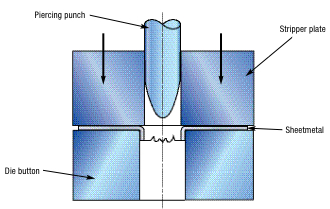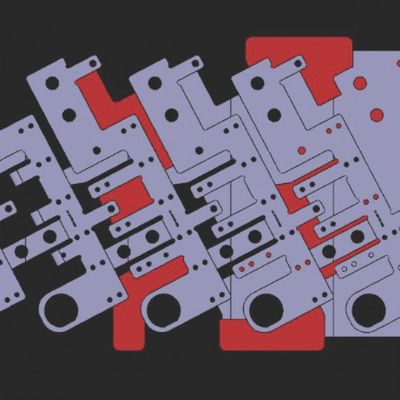Shearing is performed by a cutting blade acting upon a workpiece placed between a stationary lower cutting blade and a movable upper blade. To be classified as a shearing operation, the cutting action must be along a straight line.
Slitting is the cutting of lengths of sheetmetal into narrower lengths by use of one or more pairs of circular knives. Spacers on the slitter arbors maintain the proper blade location for the desired width. The cutting up of a wide coil (master coil) into two or more narrower coils is called slitting.
 |
| Piercing Operation |
Blanking involves cutting actions to produce a complete or enclosed shape. The blank is the piece retained for further processing. The shape may be composed of any combination of straight and curved line segments. Developed or contoured blanks used in drawing and forming operations oftentimes are generated by blanking operations. In blanking operations, offal or skeleton webs are produced. These materials often are cut up into smaller pieces and discarded as scrap.
Perforating (Punching) is generally used to describe all die-cut holes, regardless of their size or shape. In Techniques in Pressworking Sheet Metal, Eary and Reed differentiate between punching and piercing by emphasizing the fact that a slug is produced in punching operations but not in piercing work.
Piercing often is used interchangeably with punching and perforating operations. However, piercing operations are frequently (but not als) defined as “forming a hole in sheetmetal with a pointed punch with no metal fallout (slug).” The illustration depicts a piercing operation fitting this description.
Lancing makes an opening without completely separating the cut piece from the body of the metal sheet, such as for louvers. Lancing frequently is combined with bending to form tabs. No slug or scrap is produced in lancing operations.
Trimming removes unwanted material from the finished part that was required for some previous stamping operation such as drawing or stretch forming. Trimming is frequently performed on the earing zone on the top of a deep-drawn cup in order to produce a round flange. Trimming operations produce discarded offal or scrap.
Parting operations are used to separate two stampings that were formed together (usually to make two parts at one time or to balance the draw operation of a nonsymmetrical part). Parting also is an operation that involves two cutoff operations to produce contoured blanks from strip. Scrap is produced in the parting operation.
Shaving is performed on a cut edge to square it up. In general practice, five percent of the thickness of the blank is allowed for shaving.
Fineblanking is a specialized process often employed if the blank edge has an important function to perform or when square edges and no die-roll are prescribed.
These definitions should provide some clarity with regard to cutting operations. Now, if we could only clarify why a die is sometimes mounted to a punch! MF
Industry-Related Terms: Scrap,
Shearing,
Slug,
Thickness,
Webs,
Bending,
Blank,
Blanking,
Die,
Draw,
Drawing,
Edge,
Flange,
Form,
Forming,
PiercingView Glossary of Metalforming Terms Technologies: Tooling









